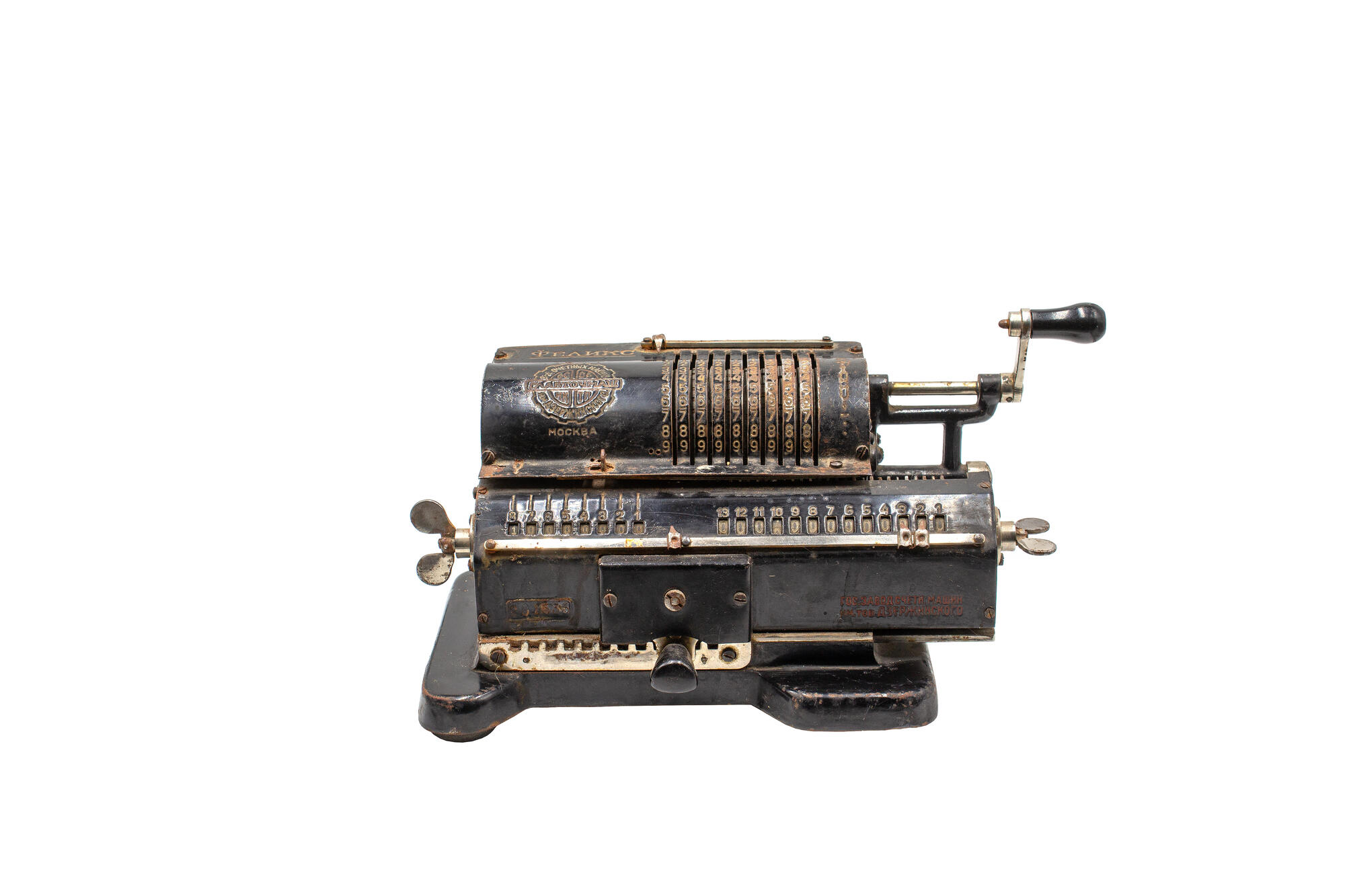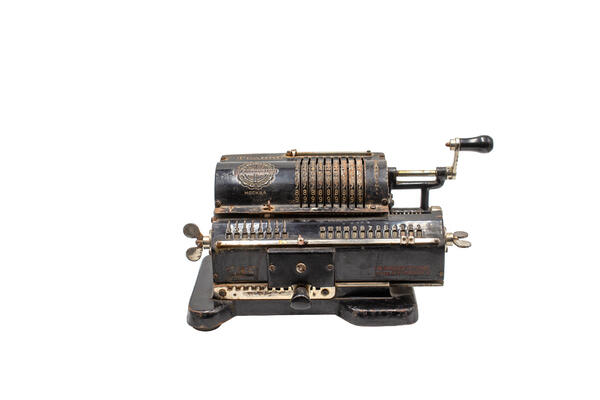The Felix arithmometer from the museum’s collection was the most popular mechanical calculator in the USSR. The arithmometer was named after Soviet politician Felix Dzerzhinsky.
An arithmometer is a tabletop or portable mechanical calculator. In the previous century, it was used to perform the basic arithmetic operations: multiplication, division, addition, and subtraction.
The Felix arithmometer consists of a stationary box with slots. By moving the nine sliders in these slots, a user can set the necessary number. To the right of the stationary box, there is a crank handle that is rotated to perform arithmetic operations. Each turn of the handle, depending on the position of the moving carriage, changes the number in one of the counter windows by one. Both the left and right sides of the carriage are equipped with a wing nut that needs to be rotated until the clicking position to reset the accumulator and the result counter.
The order of operations was always set up manually. Before performing each operation, a user had to press a corresponding button or rotate a lever.
The Felix arithmometer was a modification of the Odhner Arithmometer that was named after Swedish and Russian engineer Willgodt Theophil Odhner. He moved to St. Petersburg in 1868 and became an engineer in a local mechanical workshop. Later he got acquainted with Ludvig Nobel, brother of Alfred Nobel, and joined the Nobel’s factory. In 1871, Odhner was repairing an arithmometer invented by a French entrepreneur Thomas de Colmar — it was the first mass-produced arithmometer. After understanding the calculator’s design, Odhner developed his own machine. The production of Odhner arithmometers was launched in 1877.
Most arithmometers were placed on the table or the knees of the user. However, there were also rare handheld versions. Their compact size distinguished them from large floor-standing calculating machines — such as Т-5М tabulating machines, or mechanical computers.
In total, there were over twenty various arithmometer versions, with several millions of such calculators produced between 1929 and 1978 by various plants. The largest number of arithmometers was produced by the Schetmash Plant in Kursk, the Penza Computer Plant, and the Moscow Computing Devices Plant named after Valery Kalmykov.
An arithmometer is a tabletop or portable mechanical calculator. In the previous century, it was used to perform the basic arithmetic operations: multiplication, division, addition, and subtraction.
The Felix arithmometer consists of a stationary box with slots. By moving the nine sliders in these slots, a user can set the necessary number. To the right of the stationary box, there is a crank handle that is rotated to perform arithmetic operations. Each turn of the handle, depending on the position of the moving carriage, changes the number in one of the counter windows by one. Both the left and right sides of the carriage are equipped with a wing nut that needs to be rotated until the clicking position to reset the accumulator and the result counter.
The order of operations was always set up manually. Before performing each operation, a user had to press a corresponding button or rotate a lever.
The Felix arithmometer was a modification of the Odhner Arithmometer that was named after Swedish and Russian engineer Willgodt Theophil Odhner. He moved to St. Petersburg in 1868 and became an engineer in a local mechanical workshop. Later he got acquainted with Ludvig Nobel, brother of Alfred Nobel, and joined the Nobel’s factory. In 1871, Odhner was repairing an arithmometer invented by a French entrepreneur Thomas de Colmar — it was the first mass-produced arithmometer. After understanding the calculator’s design, Odhner developed his own machine. The production of Odhner arithmometers was launched in 1877.
Most arithmometers were placed on the table or the knees of the user. However, there were also rare handheld versions. Their compact size distinguished them from large floor-standing calculating machines — such as Т-5М tabulating machines, or mechanical computers.
In total, there were over twenty various arithmometer versions, with several millions of such calculators produced between 1929 and 1978 by various plants. The largest number of arithmometers was produced by the Schetmash Plant in Kursk, the Penza Computer Plant, and the Moscow Computing Devices Plant named after Valery Kalmykov.


